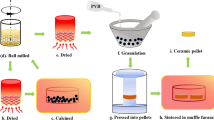Abstract
The migration of oxygen vacancies and their entrapment near film-electrode interfaces has been proposed as a cause of fatigue (i.e., polarization weakening) in ferroelectric thin film capacitors. To test this idea, lead zirconate titanate (PZT) thin films were epitaxially deposited by laser ablation on LaAlO3 substrates with yttrium barium cuprate (YBCO) base electrodes. Thin film capacitors were formed by deposition of noble metal (Pt) cap electrodes; half of them were then electrically fatigued by repeated polarization reversals (108 cycles). The distributions of oxygen in the two halves were then compared by means of accelerator-based nuclear backscattering (using the narrow elastic resonance at 3.045 MeV in the scattering of 4He from 160) throughout the bulk of the PZT films and especially right under the Pt electrodes. We were unable to detect any difference in the oxygen profiles to within the accuracy of measurement, which was about 1 % of the oxygen concentration. Compositional changes, at least involving oxygen, do not seem to be responsible for the striking electrical alterations seen in fatigued PZT.
Similar content being viewed by others
References
G. Arlt, Ferroelectrics 91, 3 (1989).
G. Arlt and U. Robels, Integrated Ferroelectrics 3, 343 (1993).
R. Moazzami, C. Hu, and W.H. Shepherd, in IEEE Proceedings IEDM, 417 (1990).
H. Hu and S.B. Krupanidhi, J. Appl. Phys. 74, 3373 (1993).
W. Pan, S. Sun, and P. Fuierer, J. Appl. Phys. 74, 1256 (1993).
Q.Y. Jiang, E.C. Subbarao, and L.E. Cross, J. Appl. Phys. 75, 7433 (1994).
D.J. Johnson, D.T. Amm, E. Griswold, K. Sreevinas, G. Yi, and M. Sayer in Ferroelectric Thin Films I, edited by E. R. Myers, and A. I. Kingon (Mat. Res. Soc. Proc. 200, Pittsburgh, PA, 1990) pp. 289–295.
P.K. Larsen, G.J.M. Dormans, D.J. Taylor, and P.J. van Veldhoven, J. Appl. Phys. 76, 2405 (1994).
D.M. Smyth, Ferroelectrics 116, 117 (1991).
I.K. Yoo and S.B. Desu, Matls. Sci. Eng. B13, 319 (1992); Phys. Stat. Sol. (a) 133, 565 (1992); in ISAF ’92: Proceedings of the Eighth IEEE International Symposium on Applications of Ferroelectrics. edited by M. Liu, A. Safari, A. Kingon, and G. Haertling (IEEE, 1992) pp. 225–228; in Ferroelectric Thin Films III, edited by E. R. Myers, B.A. Tuttle, S.B. Desu, and P.K. Larsen (Mat. Res. Soc. Proc. 310, Pittsburgh, PA, 1993) pp. 165–177.
T. Baiatu, R. Waser, K. Hardtl, J. Am. Ceram. Soc. 73, 1663 (1990).
J. Chen, M.P. Harmer, and D.M. Smyth, in ISAF ’92: Proceedings of the Eighth IEEE International Symposium on Applications of Ferroelectrics, edited by M. Liu, A. Safari, A. Kingon, and G. Haertling (IEEE, 1992) pp. 111–115. They observed donor doping to be more effective in BaTiO3 ceramics than in PZT films, where Pb vacancies from Pb loss during annealing combine with oxygen vacancies to form (VPb++-V0-) defect complexes, contributing to charge migration, and pyrochlore phase formation reduces donor incorporation into the perovskite structure.
J.-L. Peng and L.A. Bursill, Ferroelectrics 70, 191 (1986).
H.M. Duiker, P.D. Beale, J.F. Scott, C.A. Paz de Araujo, B.M. Melnick, J.D. Cuchiaro, L.D. McMillan, J. Appl. Phys. 68, 5783 (1990).
J.F. Scott, C.A. Araujo, B.M. Melnick, L.D. McMillan, R. Zuleeg, J. Appl. Phys. 70, 382 (1991).
J.R. Cameron, Phys. Rev. 90, 839 (1953).
B. Blanpain, P. Revesz, L.R. Doolittle, K. H. Purser, and J. W. Mayer, Nucl. Instr. and Meth. Phys. Res. B34, 459 (1988).
P. Revesz, J. Li, N. Szabo, Jr., J. W. Mayer, D. Caudillo, and E. R. Myers in Ferroelectric Thin Films II. edited by A. I. Kingon, E. R. Myers, and B. Tuttle (Mat. Res. Soc. Proc. 243, Pittsburgh, PA, 1992) pp. 101–106.
The ion beam energy was calibrated just before this experiment by measuring an excitation curve for the 3.045 MeV resonance on a native oxide layer on polished beryllium.
L.R. Doolittle, Nucl. Instr. and Meth. B9, 344 (1985).
The thicknesses of the PZT and YBCO layers, expressed in units of A, were calculated from the fitted atomic areal densities assuming respective bulk atomic densities of 0.71(10)23 and 0.77(10)23 at/cm3.
Author information
Authors and Affiliations
Rights and permissions
About this article
Cite this article
Pfeffer, R.L., Wilber, W.D. Nuclear Reaction Probe of Oxygen Vacancy Migration in Electrically Fatigued PZT Thin Film Capacitors. MRS Online Proceedings Library 361, 117–122 (1994). https://doi.org/10.1557/PROC-361-117
Published:
Issue Date:
DOI: https://doi.org/10.1557/PROC-361-117




